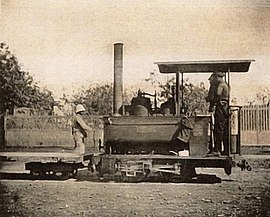Decauville Railway Diego Suarez – Camp d'Ambre
| Diego Suarez – Camp d'Ambre | |||||||||||||||||||||||||||||
|---|---|---|---|---|---|---|---|---|---|---|---|---|---|---|---|---|---|---|---|---|---|---|---|---|---|---|---|---|---|
|
Decauville locomotive of the type La Mignonne ( the cute one )
| |||||||||||||||||||||||||||||
|
Route in Antsirane, 1912
| |||||||||||||||||||||||||||||
| Gauge : | 600 mm ( narrow gauge ) | ||||||||||||||||||||||||||||
| Minimum radius : | 40 m | ||||||||||||||||||||||||||||
| Top speed: | Uphill: 11 km / h Downhill: 30 km / h |
||||||||||||||||||||||||||||
| Dual track : | In places | ||||||||||||||||||||||||||||
|
|||||||||||||||||||||||||||||
The Decauville Railway Diego Suarez – Camp d'Ambre was a 24 kilometer long Decauville - narrow-gauge railway with a gauge of 600 mm, which led in Madagascar from Antsiranana (formerly: Diego Suarez) to Sakaramy .
Construction and routing
The Decauville narrow-gauge railway with a gauge of 600 mm was built in 1900 from Antsirane (today Antsiranana) to the Tunisian fountain (Fontaine Tunisienne, at today's STAR factory). It started at the port and led up the Rue Gouraud and the Boulevard Bazeilles to the Cercle Français (now Suarez Art ) and up the Boulevard Militaire . She turned in the amount of Camp Lubert in the Boulevard de Sakaramy . From there it led past today's town hall to l'Octroi and the Tunisian fountain. At the end of 1900 the route from the Tunisian Fountain through Antanamitara and Andranomanitra was extended to the junction of today's road to Joffreville .
The route designed by Captain Brunet generally followed the course of the terrain in order to avoid large earthworks. A curve with a radius of only 40 m was necessary at the Antanamitara gorge. A 6.30 m deep cut was made over a few meters. There was also a bridge that ran diagonally across the gorge. For the track construction, Decauville rails of type No. 10 with a meter weight of 9.5 kg / m with 8 sleepers per 5 m long element were used. As a result of delivery difficulties, rails with 7.5 kg / m were used in places, which should be replaced later.
The construction of the initially 13 km long route was carried out by civil contractors from Antsirane under the direction of the engineer-captain Fénéon. Initially, the route did not contain any gravel, which ruled out the use of a locomotive. The railway operated with draft animals was partly owned by the military administration and partly privately owned. In the port, rails were laid on the quays that led to various warehouses. In 1904, the 24-kilometer stretch to Sakaramy was completed. The originally planned 10 km extension to the Camp d'Ambre military camp near Joffreville at a height of approx. 634 m above sea level was not built.
business
The trains were initially pulled by oxen and large mules , later in the lower part between the harbor and the Tunisian fountain by a steam locomotive. From 1904 the draft animals were supported by three steam locomotives. For the descent, the cars were uncoupled and braked with two independently acting brakes.
In 1908 a road was built from Sakramy to Camp d'Ambre instead of extending the narrow-gauge railway as originally planned. Due to inadequate maintenance of the tracks and steam locomotives, as well as delivery problems with spare parts and coal, steam operation was discontinued, but trains operated with draft animals continued to run. In 1911 train journeys were still made on Mondays, Tuesdays, Thursdays and Saturdays. During the war between 1914 and 1918 there was only one return trip a week. The route was still used at least in sections in 1925 and 1936.
Locomotives
At least three 0-4-0T Decauville steam locomotives, including the 3.5 tonne N ° 342/1901, were used on the route. One of the three locomotives, La Mignonne , was demonstrated on the Decauville Railway at the Paris World's Fair (1889) before being exported . It was shipped to Asia after it was taken out of service.
Individual evidence
- ↑ a b c d e f g h Suzanne Reutt: Histoire: A toute vapeur dans la campagne: les locos de Diego Suarez (2). July 25, 2012.
- ↑ a b Suzanne Reutt: Histoire de Madagascar - les Rues de Diego Suarez: le Quartier Militaire 10 July 2011
- ^ A b Rob Dickinson: Industrial Heritage in Madagascar, 2012 Part 1: Diégo Suarez.
- ↑ Suzanne Reutt: Histoire: A toute vapeur dans la campagne: les locos de Diego Suarez (1). July 25, 2012.
Coordinates: 12 ° 22 ′ 49.8 ″ S , 49 ° 18 ′ 19.4 ″ E






